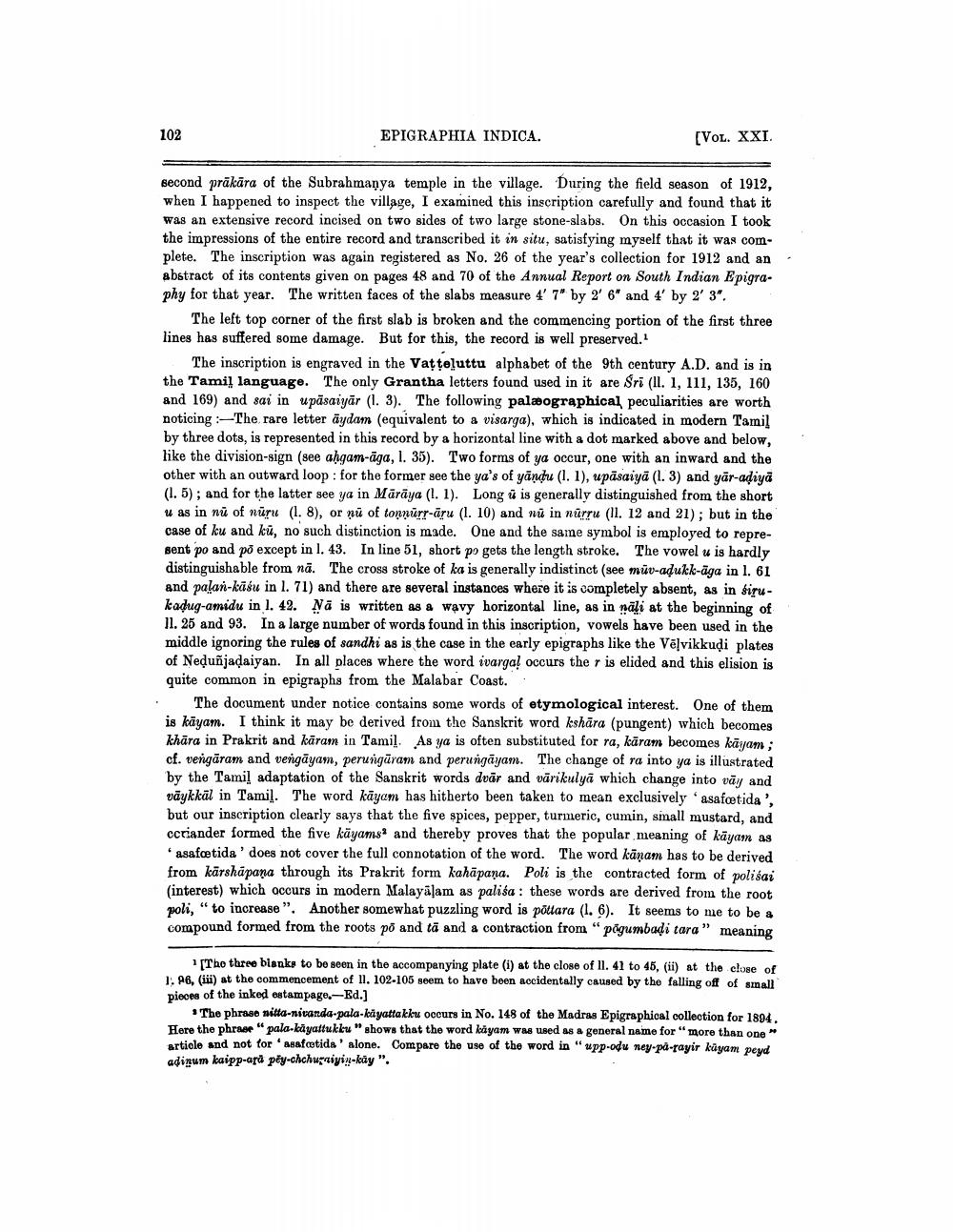________________
102
EPIGRAPHIA INDICA.
(VOL. XXI.
second präkära of the Subrahmanya temple in the village. During the field season of 1912, when I happened to inspect the village, I examined this inscription carefully and found that it was an extensive record incised on two sides of two large stone-slabs. On this occasion I took the impressions of the entire record and transcribed it in situ, satisfying myself that it was complete. The inscription was again registered as No. 26 of the year's collection for 1912 and an abstract of its contents given on pages 48 and 70 of the Annual Report on South Indian Epigraphy for that year. The written faces of the slabs measure 4'7" by 2' 6" and 4' by 2' 3".
The left top corner of the first slab is broken and the commencing portion of the first three lines has suffered some damage. But for this, the record is well preserved.
The inscription is engraved in the Vatteluttu alphabet of the 9th century A.D. and is in the Tamil language. The only Grantha letters found used in it are Sri (II. 1, 111, 135, 160 and 169) and sai in upāsaiyār (1. 3). The following palæographical peculiarities are worth noticing :-The rare letter aydam (equivalent to a visarga), which is indicated in modern Tamil by three dots, is represented in this record by a horizontal line with a dot marked above and below, like the division-sign (see ahgam-aga, 1. 35). Two forms of ya occur, one with an inward and the other with an outward loop: for the former see the ya's of yandu (1.1), upāsaiyā (1.3) and yār-adiya (1. 5); and for the latter see ya in Mārāya (1.1). Long ù is generally distinguished from the short u as in nú of nur (1.8), or nú of tonnürr-āru (1. 10) and nu in nurru (11. 12 and 21); but in the case of ku and kú, no such distinction is made. One and the same symbol is employed to represent po and po except in l. 43. In line 51, short po gets the length stroke. The vowel u is hardly distinguishable from nā. The cross stroke of ka is generally indistinct (see mūv-adukk-aga in l. 61 and palan-kāśu in l. 71) and there are several instances where it is completely absent, as in dirukadug-amidu in l. 42. Nā is written as a wavy horizontal line, as in nāli at the beginning of 11. 25 and 93. In a large number of words found in this inscription, vowels have been used in the middle ignoring the rules of sandhi as is the case in the early epigraphs like the Vēlvikkudi plates of Neduñjadaiyan. In all places where the word ivargal occurs the r is elided and this elision is
quite common in epigraphs from the Malabar Coast. • The document under notice contains some words of etymological interest. One of them
is kāyam. I think it may be derived from the Sanskrit word kshāra (pungent) which becomes khāra in Prakrit and kāram in Tamil. As ya is often substituted for ra, kāram becomes kāyam ; cf. vengāram and vengāyam, perungāram and perungāyam. The change of ra into ya is illustrated by the Tamil adaptation of the Sanskrit words dvār and värikulyā which change into vāy and väykkäl in Tamil. The word kāyam has hitherto been taken to mean exclusively asafoetida', but our inscription clearly says that the five spices, pepper, turmeric, cumin, small mustard, and ccriander formed the five kāyamsa and thereby proves that the popular meaning of kāyam as * asafoetida' does not cover the full connotation of the word. The word kāņam has to be derived from kärshapana through its Prakrit form kahāpana. Poli is the contracted form of polisai (interest) which occurs in modern Malayalam as paliśa: these words are derived from the root poli, "to increase". Another somewhat puzzling word is põllara (1. 6). It seems to me to be a compound formed from the roots po and tā and a contraction from "pogumbadi tara” meaning
The three blanke to be seen in the accompanying plate (i) at the close of II. 41 to 45, (ii) at the close of 1. 96, (iii) at the commencement of II. 102-105 seem to have been accidentally caused by the falling off of small pieces of the inked estampage.-Ed.]
The phrase nitta-nivanda-pala-kayattakku occurs in No. 148 of the Madras Epigraphical collection for 1804. Here the phrase "pala-kāyattukku" shows that the word kayam was used as a general name for more than one article and not for safetida' alone. Compare the use of the word in "upp-odu ney-på-rayir kāyam peyd adişum kaipp-ard pöy-chchuzgiyin-käy".




